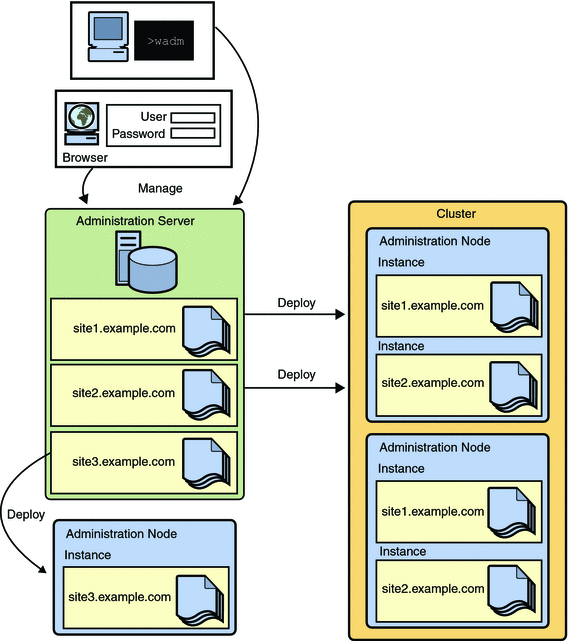Understanding Web Server 7.0
Web Server includes a new administration framework that provides enhanced distributed management across servers in a server farm. Robust administration capabilities enable Web Servers to be managed and deployed remotely using both graphical and command-line interfaces. Servers can be managed on a central location in a server farm and distributed to one or more nodes to create server instances. Monitoring and lifecycle management of these server instances are also provided.
Web Server is configured to enable you to turn various features on or off, determine how to respond to individual client requests, and write programs that run on and interact with the server’s operation. The instructions (called directives) that identifies these options are stored in configuration files. Web Server reads the configuration files on startup and during client requests to map your choices with the desired server activity.
For more information about these files, see the Web Server Administrator’s Configuration File Reference Guide.
In Web Server all configurable elements of a server instance like web applications, configuration files, and search collection indexes are logically grouped and termed as a Configuration. A Configuration can be created, modified or deleted using CLI or the web based administration interface. You can manage more then one Configuration at a time. The term Configuration also refers to the set of metadata that configures the runtime services of the server. For example, a runtime service serves web pages from a configured document root. The configuration metadata is used by the server runtime to load built-in services, third party plug-ins and setup other server extensions such as database drivers for serving web pages and dynamic web applications.
Note –
All the Configuration related files are stored in a repository in your file system called as Configuration Store. You must refrain from manually editing any of the files in this repository unless explicitly specified in this guide.
In Web Server, any change to the Configuration using the CLI or through the web-based administration interface is first made to the Configuration Store and then the Configuration is deployed. Consequently the changes are copied to the instance directory. When a web application is deployed it gets deployed under:
<install_dir>/admin-server/config-store/<config_name>/web-app/<virtual_servername>/ |
When you deploy a configuration, the entire web application directory and configuration directory under config-store is zipped up and copied to the server instance directory. This file is the current.zip file under:
<install_dir>/admin-server/config-store/<config_name> |
Depending on the size of the web application, deploying a selected configuration might take some time to complete.
The following figure shows a schematic diagram of how Configurations are deployed to Administration Nodes:

When you deploy a Configuration to a Node (Network resource, such as server or a host), an Instance of that Configuration is created. The instance contains log files and other runtime files such as lock databases, caches and temporary files that are required by the instance. You can manage these instances through the CLI or web based administration interface.
Instances can also span across one or more nodes to form a Cluster. All nodes that form a cluster must have identical configuration and be homogeneous. They must have the same operating system, be identically configured, and offer the same services.
One node in the server farm has a server running on which the administration application is deployed. This specially configured server is called the Administration Server and the administration application that is deployed is the web-based Administration Console. You use the Administration Console to control the lifecycle of server instances.
The Administration Server controls the actions of other servers in that node called as Administration Nodes. An administration node does not provide a GUI interface. One node in the server farm has the Administration Server installed. All other nodes in the server farm have Administration Nodes installed. An administration Node is registered with an Administration Server upon installation. This action will make the Administration Server aware of that Administration Node.
The Administration server and the administration node always communicate over SSL. The Administration Server and Administration Node authenticate each other by the Administration Server trusting the Administration Node's server certificate and the Administration Node trusting the client certificate presented by the Administration Server. During registration of an Administration Node, the Administration Server will generate a server certificate for that Administration Node, which is then downloaded and installed on the Administration Node. The issuer of the server certificate is also installed on the Administration Node.
- © 2010, Oracle Corporation and/or its affiliates
